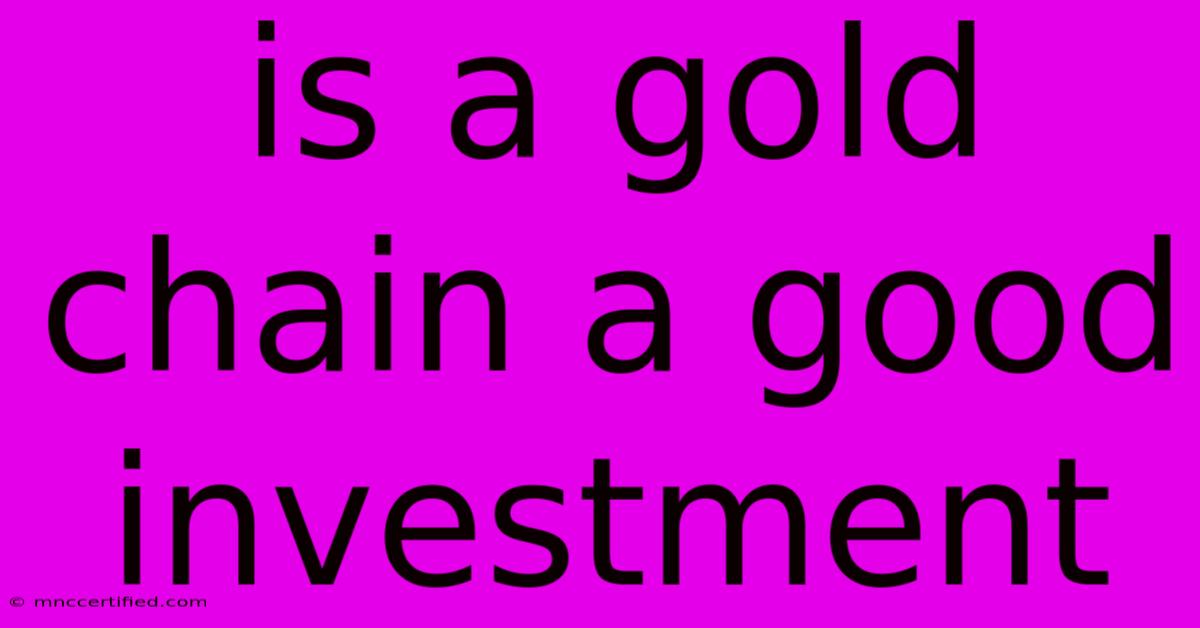Is A Gold Chain A Good Investment

Table of Contents
Is a Gold Chain a Good Investment? A Comprehensive Look
Is buying a gold chain a smart financial move? The answer, like most investment questions, is nuanced. It's not a straightforward "yes" or "no." While gold itself holds value and can appreciate over time, a gold chain's investment potential is significantly impacted by several factors. Let's delve into the pros and cons to help you decide if a gold chain is right for your investment strategy.
The Allure of Gold: Why People Invest
Gold's enduring appeal stems from its perceived stability and historical role as a safe haven asset. When economic uncertainty looms, investors often flock to gold, driving up its price. This inherent value makes it a tempting investment, particularly during periods of inflation or market volatility.
Gold's Traditional Advantages:
- Hedge Against Inflation: Gold's price often rises alongside inflation, preserving purchasing power.
- Safe Haven Asset: During economic downturns, investors see gold as a reliable store of value.
- Tangible Asset: Unlike stocks or bonds, you physically possess gold, offering a sense of security.
- Liquidity: Gold is relatively easy to buy and sell, providing some flexibility.
The Reality Check: Gold Chains as Investments
While gold holds investment potential, a gold chain presents a different story. Its value isn't solely tied to the gold's market price. Several critical factors diminish its investment viability compared to gold bullion or bars:
Disadvantages of Gold Chains as Investments:
- Manufacturing Costs: A significant portion of a gold chain's price reflects the labor and craftsmanship involved in its creation. This adds a premium beyond the raw gold value.
- Design & Style Depreciation: Fashion trends impact the value of a gold chain. An outdated design may significantly decrease its resale value.
- Resale Challenges: Selling a used gold chain can be difficult. Finding a buyer willing to pay fair market value for a pre-owned item requires effort and often involves accepting a lower price.
- Purity and Karat: The karat (e.g., 18k, 24k) significantly affects the gold's purity and, therefore, its value. Lower karat gold chains have less gold content and lower resale value.
- Hallmarking and Authenticity: Ensure your chain is properly hallmarked to verify its gold content. Counterfeit or misrepresented gold chains are a risk.
Alternative Gold Investments: Smarter Choices?
If you're aiming for gold investment, consider these options which generally offer better returns and liquidity:
- Gold Bullion (Bars and Coins): These are purer forms of gold with minimal manufacturing costs, making them more efficient investments.
- Gold ETFs (Exchange-Traded Funds): ETFs provide diversified exposure to gold without the physical storage challenges.
- Gold Mining Stocks: Investing in companies that mine gold offers leveraged exposure to the price of gold. However, this option carries higher risk.
When a Gold Chain Is a Good Choice
A gold chain isn't necessarily a bad purchase, just not always the best investment. It's a worthwhile purchase when:
- Personal Adornment: It's a piece of jewelry you enjoy wearing and appreciate.
- Heirloom Potential: A high-quality, classic gold chain can be passed down through generations, holding sentimental value.
- Limited Budget: If your budget is constrained, a smaller gold chain can be a more accessible entry point into gold ownership.
Conclusion: Weigh the Pros and Cons
Ultimately, whether a gold chain is a good investment depends on your individual priorities. If you prioritize financial returns, other gold investment options are generally more advantageous. However, if you value personal enjoyment, sentimental value, or simply want a tangible asset, a gold chain can be a satisfying purchase – just don't expect it to significantly outperform other investment vehicles. Always do your research, understand the market, and carefully consider your financial goals before making any investment decision.

Thank you for visiting our website wich cover about Is A Gold Chain A Good Investment. We hope the information provided has been useful to you. Feel free to contact us if you have any questions or need further assistance. See you next time and dont miss to bookmark.
Featured Posts
-
Invest Atlanta Affordable Housing
Nov 20, 2024
-
Velocity Investments Llc Suing Me
Nov 20, 2024
-
Central Huijin Investment Limited
Nov 20, 2024
-
Shelter Insurance Poplar Bluff Mo
Nov 20, 2024
-
Big 4 Audit To Investment Banking
Nov 20, 2024